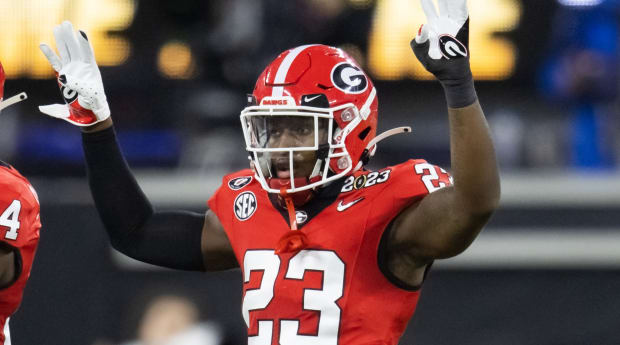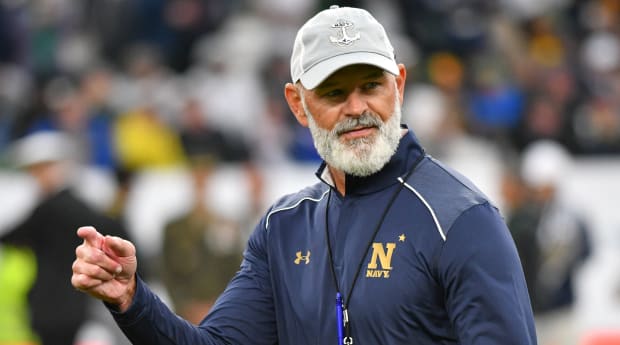Forty names, games, teams and minutiae making news in college football, where Nick Saban has joined the Depth Chart Paranoia Brigade.
First Quarter: Traditions Left Behind | Second Quarter: Bold Predictions | Third Quarter: Coaches Under Pressure
FOURTH QUARTER: THE ELUSIVE THREE-PEAT
If Georgia wins a third consecutive national championship, it would either be unprecedented or a first since 1934–36. Depends how you view these things. The Dash leans toward unprecedented.
Minnesota won three straight titles of some sort from 1934–36, but times were very different back then. The last of the three coincided with the start of the Associated Press poll, which in many respects can be considered the dawn of time in college football. The prior two were awarded to the Gophers via various entities that were contemporaries at the time or have gone back and retro-crowned them, via statistical formula.
There was something called the Toledo Cup, which was reportedly decided by a vote of 250 sports editors and Teddy Roosevelt, among others, and declared Minnesota a three-time champion. There was something called the Dickinson System, a math formula devised by a professor from Illinois, which declared Minnesota the champs in 1934 and ’36 but not in ’35 (that was SMU). But mostly there seemed to simply be a bunch of sportswriters making up their own minds and arguing about it in print, with many of them declaring the local team the best in the land.
The most glaring flaw here, of course, is that none of the games were televised and travel was limited, so most people trying to choose a national champion had never seen all the best teams play. There were a few bowl games, but a lot of schools (and some whole conferences) chose not to participate in them. What was left was regionalized, partisan guesswork. Oh, and Black people were almost completely excluded from participation.
Out of this lack of uniformity was born a lament that would echo through the sport for decades to come. “We don’t believe there is any fair way of determining the national champions unless the leaders of each section meet in a postseason round robin,” wrote Charles Johnson in the Minneapolis Daily Star in December 1934. It took only 80 years after that to come up with a four-team playoff.
Anyway, The Dash has compiled the eight most interesting near-miss three-peats and what caused them.
Watch college football with fuboTV. Start your free trial today.

Mark J. Rebilas/USA TODAY Sports
Minnesota (31), 1940–42. Cause of miss: World War II. The Gophers were the first team in the AP poll era with a chance at a three-peat. But two weeks after the Gophers finished their second straight undefeated season, in ’41, Japan struck Pearl Harbor and pulled the United States fully into World War II. Wildly successful coach Bernie Bierman, a Marine Corps reservist, was called to active duty in January ’42. Two months later he was assigned to the Navy’s new preflight training school at the University of Iowa, where he coached a team of athlete-soldiers to a 7–3 record. In an ironic plot twist, Bierman’s Iowa Pre-Flight Seahawks ended Minnesota’s 18-game winning streak early in the ’42 season, and the Gophers finished the year 5–4.
Army (32), 1944–46. Cause of miss: a 0–0 tie. West Point was on the other end of the wartime equation, gaining a huge influx of talent. After rolling undefeated to AP titles in ’44 and ’45, the Cadets retained their stellar backfield tandem of Glenn Davis and Felix “Doc” Blanchard in the postwar season of ’46. On Nov. 9, top-ranked Army and No. 2 Notre Dame battled to a scoreless deadlock in Yankee Stadium, one of the most famous tie games in college football history, and the AP pollsters rewarded the Fighting Irish with the national title.
Notre Dame (33), 1946–48. Cause of miss: fumbles. Trying for its own three-peat under coach Frank Leahy, Notre Dame’s bid for a perfect season in ’48 was scuttled by five fumbles in a season-ending, 14–14 tie at USC. Undefeated and untied Michigan was voted the national champion. The Irish would win the ’49 title, narrowly missing a four-peat.
Oklahoma (34), 1955–57. Cause of miss: Notre Dame. The Sooners of that era still hold the record for longest winning streak in FBS history at 47 games, winning the ’55 and ’56 titles during that time. But the streak came to an end in the ’57 season with a 7–0 home loss to Notre Dame. Auburn (AP) and Ohio State (UPI) split the national title, with the Tigers on probation and ineligible for the UPI crown.
Miami (35), 1987–89. Cause of miss: a bad fumble call. Miami won the ’87 and ’89 titles, but lost the ’88 crown in a one-point defeat at Notre Dame—the famous “Catholics vs. Convicts” game, to quote the T-shirts that were hot sellers in South Bend. The Hurricanes had an officiating beef in that one, with Cleveland Gary fumbling at the 1-yard line to stop a late drive. In the days before replay review, there was no overturning the call after it was shown that Gary’s knee was clearly down before he fumbled.
USC (36), 2003–05. Cause of miss: Vince Young. The Trojans split the ’03 national championship with LSU, won the ’04 title with ease by routing Oklahoma and carried a 34-game winning streak into the BCS championship game the next season against undefeated Texas. Leading 38–33 with 2:13 left, a LenDale White run on fourth down was stopped inches short of what would have been a clinching first down. Then Young cemented his place in the lore of the sport with a do-everything drive for the winning score with 19 seconds left.
Alabama under Nick Saban twice (37), 2011–13 and ’15–17. Causes of misses: the Kick Six and Deshaun Watson–to–Hunter Renfrow. Bama’s ’11 and ’12 titles were followed by an 11–0 start in ’13, but the three-peat was stopped by one of the wildest plays in the history of the sport: Chris Davis’s walk-off, 109-yard return of a potential game-winning Crimson Tide field goal that came up short. Saban’s ’15–17 run featured titles on both ends but a five-point loss in between, to Clemson in the College Football Playoff title game. That one ended on a two-yard pass from Deshaun Watson to Hunter Renfrow with one second left.
COACH WHO EARNED HIS COMP CAR THIS WEEK
Marcus Freeman (38), Notre Dame. Maybe it doesn’t matter how nice Freeman is, if his team is going to perform like it did in the Week Zero beatdown of Navy. The 169 yards allowed was the fewest by a Fighting Irish defense since October 2020, and the 39-point margin of victory was the largest for the Irish in a season opener since ’12. Then again, maybe this was a product of the competition …

Matt Cashore/USA TODAY Sports
COACH WHO SHOULD TAKE THE BUS TO WORK
Brian Newberry (39), Navy. Great beard, but everything else was ugly. The Midshipmen have elevated the season-opening debacle to an art form, losing four straight by margins of 52, 42, seven (to Delaware) and now 39. This was Newberry’s debut as head coach, taking over from Ken Niumatalolo, but the opening malaise looked much the same. Navy is small up front defensively, still can’t throw the ball and was unable to spring any big plays in the option game.







